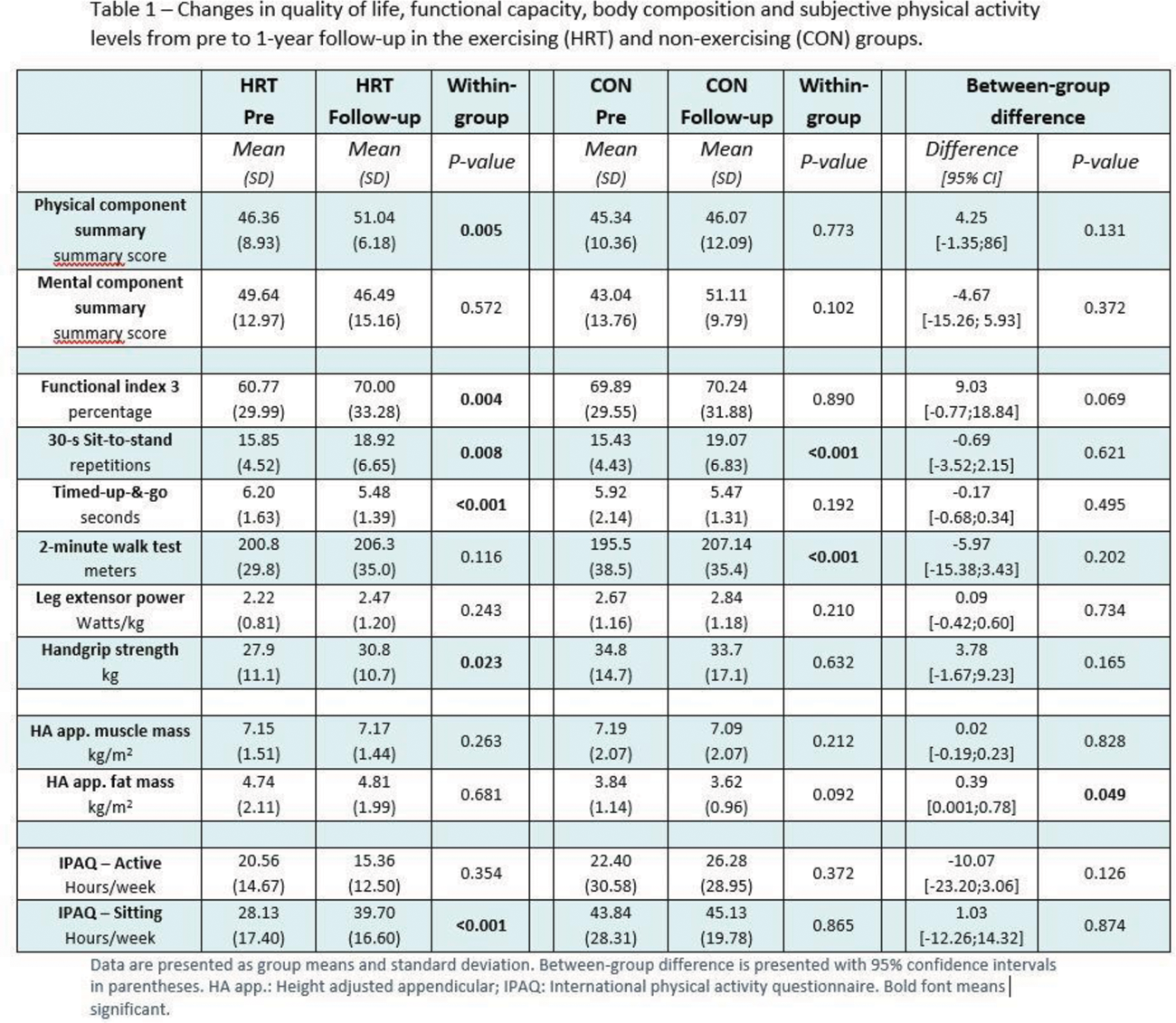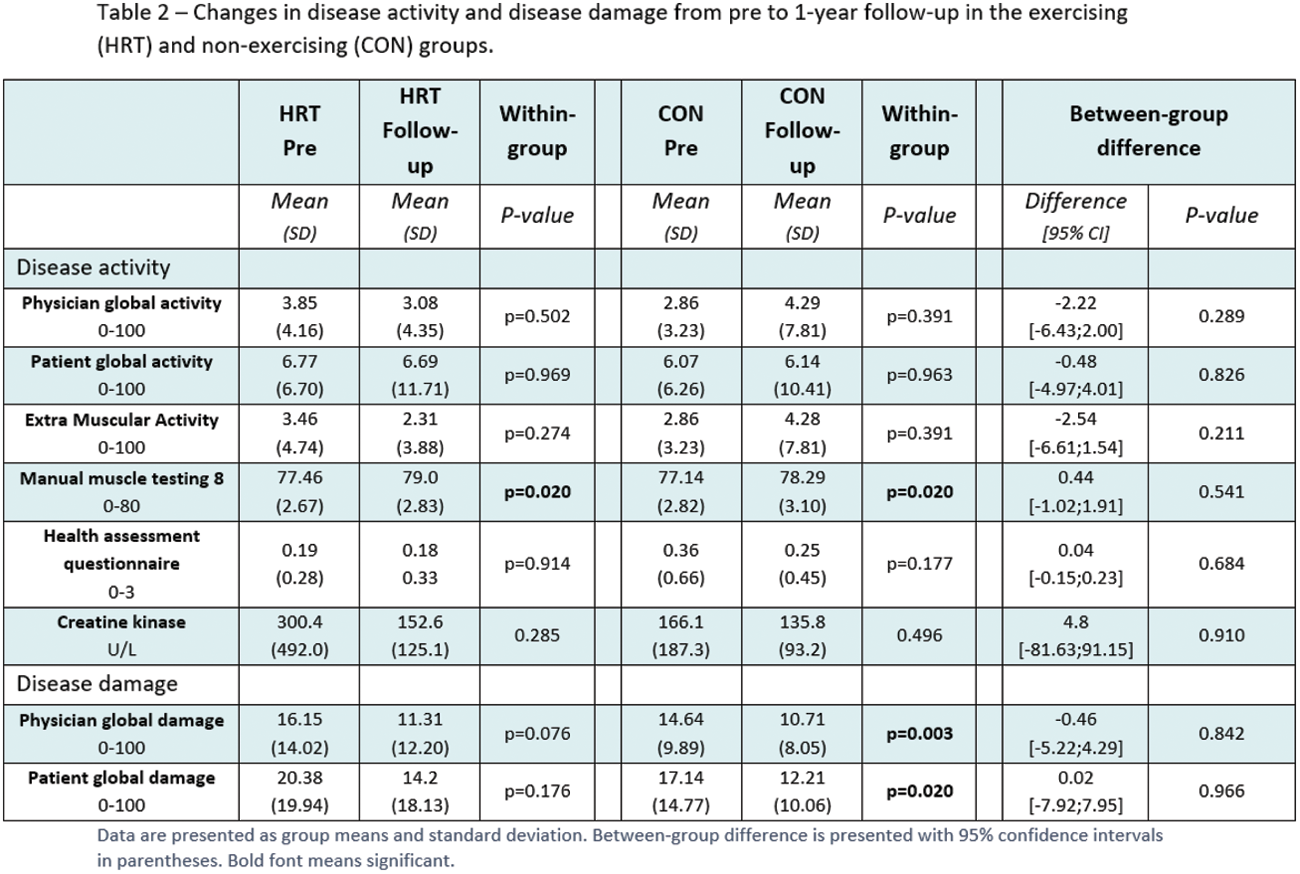

Background: Reduced muscle endurance and strength are cardinal traits in patients with myositis[1]. These traits are associated with reduced quality of life[2], thus an increase in endurance and strength could potentially lead to improved quality of life. Our randomised controlled trial (RCT) (NCT04486261) investigated the effects of 16 weeks of progressively adjusted high-intensity resistance training on the quality of life in patients with myositis. Increases in quality of life, muscle strength and muscle endurance were observed immediately following the 16-week intervention period for participants allocated to high-intensity resistance exercise compared to non-exercising controls. However, it is unknown to which extent these positive changes are sustained over time.
Objectives: To investigate if the effects of 16 weeks of high-intensity resistance exercise persist at the 1-year follow-up in patients with myositis.
Methods: In the RCT, 32 patients with myositis were allocated to 16 weeks of high-intensity resistance training (HRT, n=15) or 16 weeks of care-as-usual (CON, n=17). In the present follow-up study, outcomes were compared from baseline (week 0) to 1-year follow-up (week 52). Following the 16 weeks of intervention, both groups were given training programs and encouraged to exercise. Twenty-seven patients completed follow-up (HRT, n=13; CON, n=14) and were included in the per protocol analysis. The primary outcome was quality of life (Short Form 36, physical component summary). Secondary outcomes included functional capacity (incl. functional index 3, 30-s sit-to-stand, timed-up-&-go, 2-minute walk test and handgrip strength), body composition by DEXA (height-adjusted appendicular muscle and fat mass), self-reported levels of physical activity and measures of disease activity and damage (incl. health assessment questionnaire, manual muscle testing 8, physician and patient global activity, and physician and patient global damage). Paired t-testing was used to perform within-group comparisons between baseline and 1-year follow-up. Further, a linear model was used to evaluate between-group differences over time.
Results: HRT demonstrated increases in physical component summary (p=0.005), functional index 3 (p=0.004), 30-s sit-to-stand (p=0.008), timed-up-&-go (p<0.001) and handgrip strength (p=0.023) at 1-year follow-up compared to baseline, while 30-s sit-to-stand (p<0.001) and 2-minute walk test (p<0.001) were improved in CON (Table 1). Reduced levels of physical activity were observed in HRT (p<0.001) (Table 1). In disease activity and damage measures, only manual muscle testing 8 increased for HRT (p=0.020). In CON, manual muscle testing 8 (p=0.020), physician (p=0.003) and patient global damage (p=0.020) were improved at 1-year follow-up (Table 2). With the exception of the height-adjusted appendicular fat mass (p=0.049), no between-group differences over time were observed (Table 1 & Table 2).
Conclusion: Myositis patients allocated to 16 weeks of high-intensity resistance training showed sustained within-group improvements in physical quality of life, functional capacity and muscle strength at 1-year follow-up. However, these sustained improvements were not superior to care-as-usual, as the group also improved in some functional parameters and muscle strength at 1-year follow-up. No signs of increased disease activity or damage were observed at 1-year follow-up.
REFERENCES: [1] Lundberg IE, Fujimoto M, Vencovsky J, et al. Idiopathic inflammatory myopathies. Nat Rev Dis Primers. 2021;7(1):86. Published 2021 Dec 2. doi:10.1038/s41572-021-00321-x.
[2] Poulsen KB, Alexanderson H, Dalgård C, Jacobsen S, Weile L, Diederichsen LP. Quality of life correlates with muscle strength in patients with dermato- or polymyositis. Clin Rheumatol. 2017;36(10):2289-2295. doi:10.1007/s10067-017-3706-6.


Acknowledgements: Physiotherapist, PhD student Charlotte Grønset performed all physical function tests and her help was an indispensable for the completion of the current study.
Disclosure of Interests: None declared.